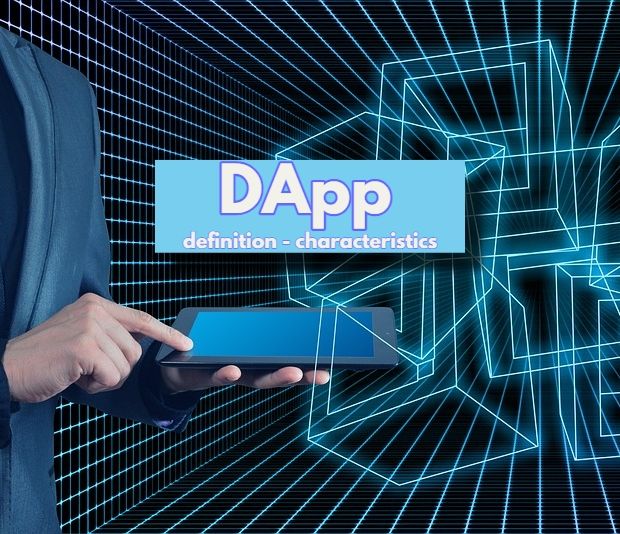What is a DApp? We’re hearing more and more about DApps, but do you know exactly what they are? Definition, features and examples.
DApp, four letters that stand for what? If you’ve been following Web3 and blockchain news, you’ve probably already heard a lot about it, since it’s actually a decentralized application. Here’s the full definition and characteristics.
DApp – definition & characteristics:
DApp stands for Decentralized Application.
It’s an application that runs on a decentralized network rather than a centralized server.
This is a software application whose operation is distributed and duplicated within a group of multiple smart contracts, either partially or totally. It is generally based on one or more smart contracts running on one or more blockchains.
Here are some key characteristics of DApps:
- Decentralization: Unlike traditional applications that rely on centralized servers, DApps operate on decentralized networks such as blockchain. This means there is no single point of control or failure, enhancing resilience and censorship resistance.
- Open Source: DApps are typically built on open-source code, allowing anyone to inspect, modify, or contribute to the codebase. This fosters transparency, community collaboration, and innovation.
- Cryptographic Security: DApps often leverage cryptographic techniques such as digital signatures and cryptographic hashing to ensure the security and integrity of transactions and data. This enhances trust among users and minimizes the risk of fraud or tampering.
- Tokenization: Many DApps have their own native tokens or cryptocurrencies that facilitate transactions and incentivize network participants. These tokens can represent various assets, rights, or utilities within the DApp ecosystem.
- Smart Contracts: DApps often utilize smart contracts, which are self-executing contracts with the terms of the agreement directly written into code. Smart contracts automate and enforce the execution of transactions or agreements, eliminating the need for intermediaries and reducing costs.
- Interoperability: DApps can interact with other DApps or blockchain networks through standardized protocols and interfaces. This interoperability allows for seamless integration and the creation of complex decentralized ecosystems.
- Immutability: Once data is recorded on a blockchain, it is extremely difficult to alter or delete, thanks to the cryptographic properties of the underlying technology. This immutability ensures the integrity and permanence of the data stored within DApps.
- Community Governance: Governance mechanisms within DApps are often decentralized, allowing stakeholders to participate in decision-making processes such as protocol upgrades, parameter changes, and allocation of resources. This democratic approach empowers users and fosters a sense of ownership and accountability.
What we can deduce:
Overall, DApps represent a paradigm shift in how applications are designed, developed, and deployed, offering greater transparency, security, and inclusivity compared to traditional centralized counterparts.
In short, a decentralized application, or DApp, is an application whose operation is, at least in part, distributed and replicated across a network of diverse actors.
A DApp can be set up in many different ways, but it is often based on a blockchain, a reputedly unforgeable ledger.
This generally includes:
- One or more autonomous contracts (smart contracts) running on a blockchain (or even several).
- A transparent user interface.
- A distributed data storage model.
- A peer-to-peer message communication protocol.
- A decentralized name resolution system.
Not all of these elements need to be present, and not all of them need to be decentralized to the maximum extent to qualify as a decentralized application.
Smart contracts and DApps
At the heart of a DApp lies its smart contract(s). These self-executing contracts are software programs that operate independently of a trusted third party and automatically trigger upon specific conditions being met within the blockchain environment they inhabit.
Typically, they are designed to function on dedicated platforms like Ethereum, Tezos, Cardano, or EOS. Nevertheless, a contract can also find a home on its own blockchain. The primary advantage of « smart » contracts is the elimination of intermediaries who validate actions. Moreover, as all transactions conducted within a contract are logged on the blockchain, accessing the history of these transactions becomes effortless.
Another noteworthy benefit of smart contracts is their efficiency: executing transactions through this technology is comparatively inexpensive, rapid, and secure. This translates to substantial cost savings in various sectors compared to traditional businesses that do not leverage such programs.
The DApp user interface
Although a DApp is often associated with the smart contract on which it is based, it often goes beyond this simple definition. Indeed, for a user to interact with a smart contract, an interface is often required.
This interface is usually implemented via a (usually centralized) website, acting as a link between the smart contract and the software used by the user.
Here are a few examples of DApps in various fields:
Decentralized finance (DeFi):
- Uniswap: A decentralized exchange platform (DEX) enabling the exchange of Ethereum tokens and other digital assets without intermediaries.
- Compound: A decentralized lending and borrowing protocol allowing users to earn interest by lending crypto-currencies or borrowing funds.
- MakerDAO: A decentralized stablecoin system where Dai stablecoin is generated by collateral locked in smart contracts.
- Gains.trade: Decentralized trading platform enabling brokerless trading in cryptos, forex and commodities.
Decentralized games (Blockchain Gaming):
- CryptoKitties: A crypto-cat collecting game where players can buy, sell and breed unique virtual cats on the Ethereum blockchain.
- Axie Infinity: A game of strategy and breeding of creatures called Axies, where players can earn rewards by playing and fighting.
NFT (Non-Fungible Tokens):
- Rarible: A decentralized market platform for buying, selling and trading non-fungible tokens (NFTs) representing digital artworks, trading collections and more.
- Decentraland: A decentralized virtual reality platform where users can buy, sell and own virtual plots of land and create interactive experiences.
Decentralized governance:
- Aragon: A decentralized governance platform enabling organizations to create, manage and govern their own decentralized autonomous structures (DAOs).
- DAOstack: A platform that enables the creation and management of complex DAOs (Decentralized Autonomous Organizations), with a focus on efficiency and scalability of decisions.
Logistics and supply chain:
- VeChain: A supply chain management platform that uses blockchain technology to track and verify the authenticity of products across the entire supply chain.
- Provenance: A blockchain platform that enables companies to trace and verify the origin and authenticity of products, promoting transparency and sustainability in supply chains.
These examples illustrate the diversity of use cases for DApps and demonstrate how blockchain technology can be applied in different sectors to create innovative decentralized applications.


Un commentaire sur « DApp – definition and characteristics »
Les commentaires sont fermés.